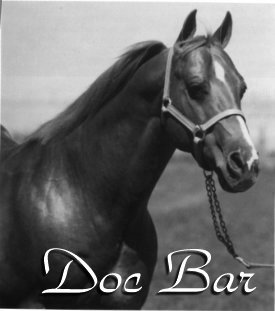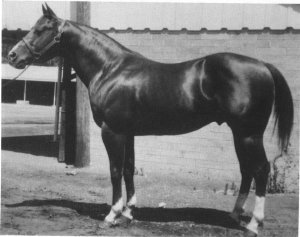



For Finley Ranch in Arizona, they hoped Doc Bar's birth in 1956 meant
another racing champion. The progeny of Dandy Doll, a petite mare with a stack of racing
awards, and Lightning Bar, an outstanding stallion with a first-class racing reputation,
the exceptionally smart, stocky stallion came with a blue-blood racing pedigree, the look
of a champion, and a curiousity for people.
Doc Bar, however, proved there are no guarantees in breeding. By the time he
was old enough to earn his keep, he merited only the rating of an A runner, and won a
meager $95.00 after 4 racing attempts. The hopes of a racing career plummeted, the
expectations of championships withered. What seemed a failure, though, ironically became a
door to success in an unusual twist in the equine world. Within the decade, the halter
industry and the performance industry were destined for revival because of one failed race
horse, Doc Bar.
Tom Finley, disillusioned by the performance and wanting to sell Doc Bar,
sent him to California with well-known trainer Charley Araujo. The majority of the horses
competing in any class in the 50's and 60's also showed in halter, so Araujo fitted Doc
Bar for halter competition.
Not only was the stallion unknown in the halter ring, his refined
conformation was different from that of the raw-boned plow horses accepted then as halter
class champions. Araujo, however, still chose the halter ring as the proving ground for
Doc Bar, and his agenda worked. The halter world was ripe for change, and with the
combination of a noted showman, and a horse whose conformation was unique to previous
champions, the guidelines for halter horse champions altered almost overnight.
Out of 15 shows, Doc Bar earned 12 first place ribbons, three seconds, nine
grand champion titles and one reserve. Doc Bar and his offspring swept halter class after
halter class, causing the stallion's breeding career to quickly soar. In the pinnacle of
success, Charley Araujo widely retired Doc Bar from the ring.
A second career, however, loomed in the immediate future. The flashy stallion
caught the eye of Double J Ranch owners, Dr. and Mrs. Steven Jensen. The couple purchased
him in 1963, taking him to Paicines, California where he stood to their broodmare band.
Instead of mares bred only for halter, the Jensens' broodmares were daughters of Poco
Tivio, King, Leo and Hollywood gold. When the first foal drop became show-age, their
son-in-law, Charlie Ward, a cowboy with a hankering for cutting horses, broke and trained
them for the performance arena.
Again the time was ripe for change. The look of halter champions that Doc Bar
had revolutionized years earlier once more shifted in style and conformation. Fewer and
fewer Doc Bar progeny won the blue ribbons in the halter classes, but the colts Charlie
Ward took into the cutting arena raised eyebrows. In fact, two of the first Doc Bar colts,
Fizzabar and Janie Bar, has already gained reputations in the performance industry.
Under the guiding hand of reown cutting horse trainer Don Dodge who
introduced the sport of cutting to California, Fizzabar became a serious contender in
cutting competions. In 1967 and 1968, she ranked high in the Top Ten standings of the
National Cutting Horse Association, (NCHA) and in 1968 she also took home the title of
World Champion Cutting Mare. She, and her sire Doc Bar, became household names in the
cutting world.
At the same time, cutting horse owners eyed the pedigree of Fizzabar, the
Jensens purchased the famous cutting mare Loco Lena, another Dodge-ridden mare who had won
World Champion Cutting Mare as well as Reserve World Champion Cutting Horse and been in
the NCHA Top Ten Horses for 10 years. Although now retired and seriously foundered, when
bred to Doc Bar, Poco Lena produced Doc O'Lena in 1967 and Dry Doc in 1968.
In 1970, Doc O'Lena won all four go-rounds of the coveted National Cutting
Horse Association Futurity, a record still unbroken today. The following year, Dry Doc won
the NCHA Futurity. Two more Doc Bar progeny followed in their footsteps. Doc's Marmoset
captured the title in 1973 and Doc's Yuba Lea won the title in 1974.
Doc Bar mania exploded and breeding sky-rocketed as the Doc Bar name
literally reverberated whenever cutting commanded the conversation. Almost like the
California Gold Rush of 1849, mare owners pounded the pavement to Paicines, California,
trailering their mares to the court of Doc Bar. The stallion, far off the beaten path in a
remote valley reaches by winding roads, once again revolutionized an industry, just as he
and his offspring revolutionized the halter industry years earlier.
Ironically, Doc Bar, himself, never competed in the cutting arena. Rather,
his credentials as a cutting horse sire developed from his progeny, , who dominated the
event year after year, thus promoting his title as sire of cutting champions. When Doc Bar
retired from service in 1978, he has sired 485 registered foals. His sons and daughters
dominated not only the National Cutting Horse Association competitions, but competitions
in the American Quarter Horse Association as well. Even though the majority of his foals
were born after his halter hey-day, 101 Doc Bar offspring were open halter point earners.
In performance classes, 207 were point earners: two AQHA World Champions, four Reserve
World Champions, 27 AQHA open champions and 20 won Superior honors. Because of his great
success and that of his progeny, Doc Bar received the honor of induction into the AQHA
Hall of Fame. Today, Doc Bar bloodlines still dominate the winner's circle in cutting
events, and more horses carry the name "Doc" in their pedigree than any other
name. Without his failure at the race track, the stallion with racing blood coursing
through his veins might never have known a halter class. His offspring might never have
seen a cutting arena. He might never have changed the style of the halter horse, or become
known as the sire of champions in the cutting horse world. In breeding there are no
guarantees.
| Doc Bar (1956-1992) |
Lightning Bar | Three Bars (TB) | Percentage |
| Myrtle Dee | |||
| Della P | Doc Horn | ||
| Mare by Old D.J. | |||
| Dandy Doll | Texas Dandy | My Texas Dandy | |
| Streak | |||
| Bar Maid F. | Bartender II | ||
| Nelly Bly |